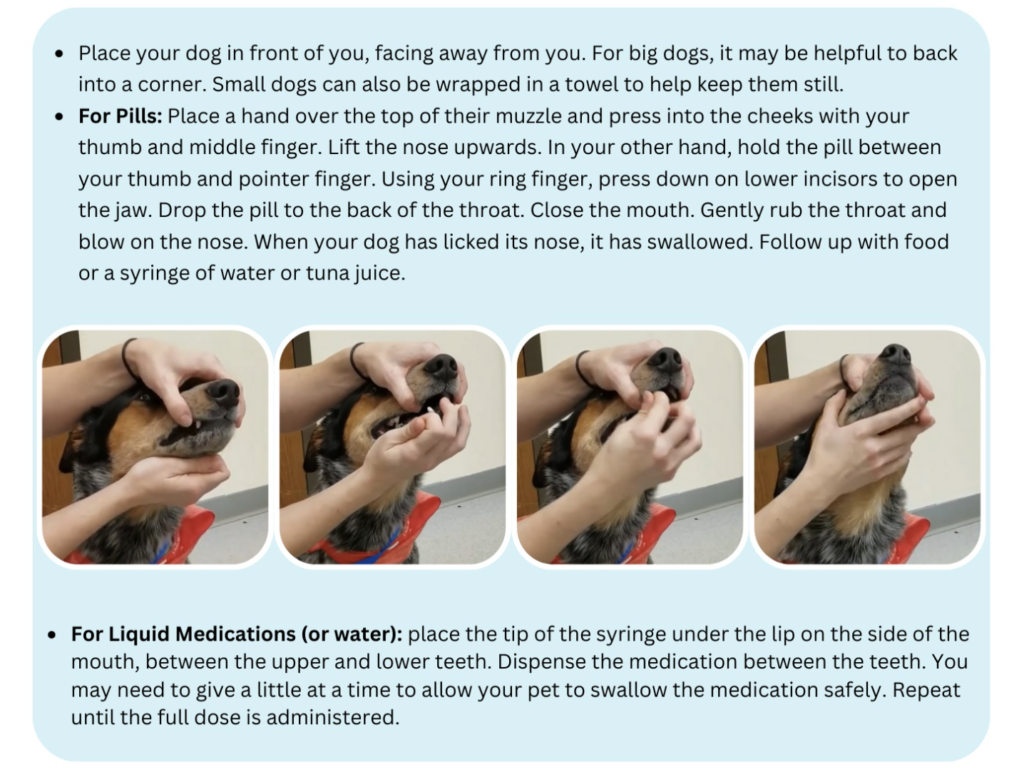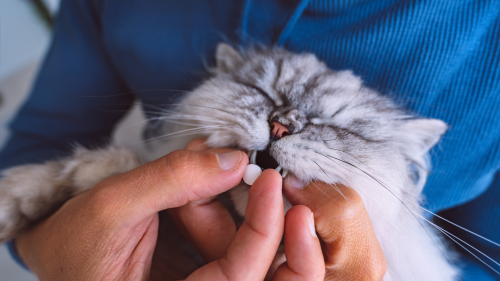As experienced pet sitters in Columbus, Ohio, we’re always putting pets’ health and wellness at the top of our priority list. A crucial aspect of pet care is administering medications correctly. Whether you’re managing a reluctant cat or a playful dog, this guide will provide essential dos and don’ts, tips, and tricks for giving various medications to pets safely and effectively.
Understanding the Medication
Types of Medications
- Oral: Tablets, capsules, or liquid form.
- Topical: Creams, ointments, or sprays applied to the skin.
- Injectable: Administered via injection, often by a veterinarian.
- Eye/Ear Drops: Specific to ocular or auditory conditions.
Key Considerations
- Read Instructions: Always read and understand the medication instructions provided on the packaging and by the vet.
- Know the Dosage: Double-check the dosage to avoid underdosing or overdosing.
- Expiration Date: Ensure the medication is not expired.
Tips and Tricks for Administration
Oral Medications
Oral medications come in the form of tablets, capsules, or liquids. Here are some tips and tricks to help you administer these medications effectively:
- Tablets and Capsules:
- Hiding in Food: Hide the pill in a small amount of their favorite food, such as cheese, peanut butter, or a specially designed pill pocket. Ensure the pet consumes the entire treat to get the full dose.
- Manual Administration (see image below): If hiding the pill doesn’t work, gently open the pet’s mouth, place the pill at the back of their tongue, close their mouth, and gently stroke their throat to encourage swallowing.
- Crushing Pills: Some tablets can be crushed and mixed with food or water. However, consult your vet first, as not all medications should be crushed.

- Liquid Medications:
- Syringe or Dropper: Use a syringe or dropper to administer liquid medicine. Gently insert it into the side of the pet’s mouth and slowly release the medication to avoid choking or spitting.
Topical Medications
Topical medications include creams, ointments, or sprays applied to the skin. Here are some tips and tricks for applying topical medications:
- Clean the Area: Ensure the application area is clean and dry before applying the medication.
- Apply Evenly: Spread the medication evenly over the affected area, ensuring it is absorbed properly.
- Prevent Licking: Use an Elizabethan collar (cone) or distract your pet to prevent them from licking or scratching the treated area until the medication dries or absorbs.
Injectable Medications
Injectable medications are usually administered via injection and often require a veterinarian. However, in some cases, pet parents themselves may need to give injections at home. Here are some tips and tricks:
- Get Proper Training: Ensure you receive proper training from your veterinarian on how to give injections safely.
- Calm Environment: Administer injections in a calm and quiet environment to reduce stress for your pet.
- Correct Technique: Follow the recommended injection technique, whether it’s subcutaneous (under the skin) or intramuscular (into the muscle). Always use a new, sterile needle and syringe for each injection.
Eye/Ear Drops
Eye and ear drops are specific to ocular or auditory conditions. Here are some tips and tricks for administering these medications:
- Clean the Area: Clean the eye or ear area with a damp cotton ball to remove any debris or discharge.
- Proper Positioning: Hold your pet securely and gently tilt their head. For eye drops, aim the dropper above the eye without touching it. For ear drops, gently pull the ear flap and apply the drops into the ear canal.
- Massage: After administering, gently massage the base of the ear to help distribute the medication.
General Dos and Don’ts for Giving Meds
Dos
- Do Follow Instructions: Always follow the veterinarian’s instructions and the medication’s label directions carefully.
- Do Use Pill Pockets or Treats: Use pill pockets or treats to hide medications, making it easier for your pet to take them.
- Do Keep a Schedule: Administer medications at the same time each day to maintain a consistent routine and ensure you don’t miss a dose.
- Do Monitor for Side Effects: Watch for any side effects or reactions after giving the medication. Contact your vet if you notice any unusual behaviors or symptoms.
Don’ts
- Don’t Crush Pills Without Approval: Never crush or alter medications unless your vet confirms it’s safe.
- Don’t Use Human Medications: Never give human medications to pets without consulting your veterinarian, as some can be toxic to animals.
- Don’t Skip Doses: Do not skip doses, as it can affect the medication’s effectiveness and your pet’s recovery.
- Don’t Force Medication: Forcing medication can cause stress and injury. Use gentle techniques and positive reinforcement.
Administering medications to pets can be challenging, but with patience and the right techniques, you can ensure their health and well-being. If you’re ever unsure or need assistance, consult your veterinarian for guidance. Your pet’s health is worth the extra effort and care.















